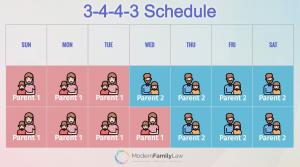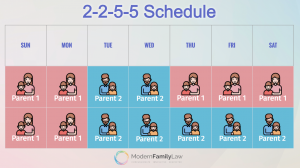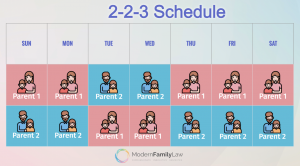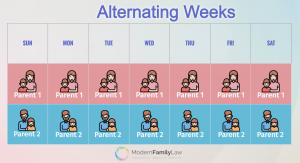The 3-4-4-3 Schedule
The 3-4-4-3 custody schedule, where the child resides with one parent for three days and then with the other for four days, alternating each week, presents a blend of regularity and variation. This schedule offers unique benefits and poses certain challenges.
Benefits of the 3-4-4-3 Schedule
1. Balanced Involvement: This arrangement allows both parents to be equally involved in their child’s life, ensuring a balanced share of both the joys and responsibilities of parenting.
2. Consistent Yet Flexible: The schedule provides a consistent routine, which is beneficial for the child’s sense of security, while also offering some flexibility to accommodate various family activities.
3. Reduced Adjustment Time: With the alternation happening weekly, children have less frequent transitions, which can be easier for them to manage emotionally and logistically, compared to schedules with more frequent swaps.
4. Suitable for Various Ages: This format can work well for children of different ages, providing a good balance of time with each parent without long separations.
Challenges of the 3-4-4-3 Schedule
1. Need for Proximity and Coordination: Given the weekly transitions, this schedule works best when both parents live relatively close to each other and to the child’s school or daycare.
2. Communication Demands: This format requires a high level of communication and cooperation between parents to manage transitions, share updates about the child’s life, and coordinate various activities and responsibilities.
3. Potential for Disruption: While the transitions are less frequent than some other schedules, they can still disrupt routines, especially if the handovers aren’t well managed or if the child struggles with changes.
4. Adjustment for the Child: Some children might find the weekly change challenging, particularly if they have different routines or rules at each parent’s home.

The 3-4-4-3 custody schedule is a viable option for parents who can maintain good communication and live close. It offers a balanced approach to parenting time, although it demands a high level of coordination and adaptability from both parents and children.









